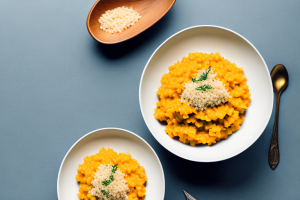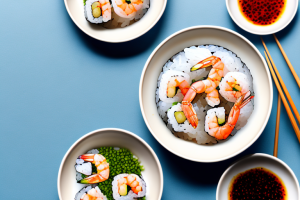How to stir-fry wild rice with Asian garlic ginger sauce
9 min read
A pan with wild rice and asian garlic ginger sauce being stir-fried
Are you tired of the same old rice dishes? Why not try stir-frying wild rice with an Asian garlic ginger sauce? Not only is it a unique and flavorful dish, but it also provides numerous health benefits. Let’s explore the step-by-step process of creating this delicious and nutritious meal.
The health benefits of wild rice
Wild rice is a healthy alternative to white rice and contains more nutrients, including antioxidants, minerals, and vitamins. It is also lower in calories and fat. Additionally, wild rice is a good source of protein and fiber, making it an excellent choice for vegetarians and vegans.
Studies have shown that consuming wild rice can help reduce the risk of chronic diseases such as heart disease, diabetes, and certain types of cancer. This is due to the high levels of antioxidants found in wild rice, which help to protect the body against oxidative stress and inflammation.
Furthermore, wild rice is a gluten-free grain, making it a great option for those with celiac disease or gluten intolerance. It is also a versatile ingredient that can be used in a variety of dishes, from salads and soups to casseroles and stir-fries.
Understanding the basics of stir-frying
Stir-frying is a fast and simple cooking method that involves cooking food quickly over high heat in a wok or pan. The key to successful stir-frying is to have all ingredients prepped and ready before beginning to cook.
One of the benefits of stir-frying is that it allows you to cook a variety of ingredients together, making it a great way to use up leftover vegetables or meats. Additionally, stir-frying is a healthier cooking method as it requires less oil than other cooking methods like deep-frying.
When stir-frying, it’s important to use high heat and to constantly stir the ingredients to prevent them from sticking to the pan. You can also add sauces or spices to enhance the flavor of the dish. Some popular stir-fry sauces include soy sauce, oyster sauce, and hoisin sauce.
The essential ingredients for an Asian garlic ginger sauce
To make an Asian garlic ginger sauce, you will need soy sauce, rice vinegar, honey, ginger, garlic, sesame oil, and cornstarch. These ingredients create a savory and slightly sweet sauce that pairs perfectly with wild rice.
One of the key benefits of using an Asian garlic ginger sauce is that it adds a burst of flavor to any dish. The combination of soy sauce, rice vinegar, and honey creates a perfect balance of salty, sour, and sweet flavors that can enhance the taste of any meal.
Another great thing about this sauce is that it is incredibly versatile. You can use it as a marinade for meats, a dipping sauce for dumplings, or even as a dressing for salads. The possibilities are endless, and you can experiment with different ingredients to create your own unique version of this delicious sauce.
Preparing the wild rice for stir-frying
Before you begin stir-frying, you need to prepare the wild rice. Rinse the rice thoroughly and soak it in cold water for 30 minutes. Drain the water and add the rice to a pot with three cups of water and a pinch of salt. Cover and bring to a boil. Then reduce the heat and let it simmer for 40-45 minutes until the rice is cooked and tender.
It’s important to note that wild rice can take longer to cook than regular rice, so be sure to check the texture and taste before using it in your stir-fry. Additionally, you can add some flavor to the rice by cooking it in broth instead of water, or by adding herbs and spices to the cooking water.
How to make a perfect Asian garlic ginger sauce from scratch
Mix together one tablespoon of soy sauce, one tablespoon of rice vinegar, one tablespoon of honey, one teaspoon of grated ginger, two cloves of minced garlic, one teaspoon of sesame oil, and one tablespoon of cornstarch. Whisk until the cornstarch dissolves, and the mixture becomes smooth.
This sauce is perfect for stir-fries, marinades, and dipping sauces. For a thicker consistency, add more cornstarch. You can also adjust the sweetness or saltiness to your liking by adding more honey or soy sauce. This sauce can be stored in an airtight container in the refrigerator for up to a week.
Tips for selecting the right wok or pan for stir-frying
The ideal wok or pan for stir-frying is a carbon steel or cast-iron pan. It should have a flat bottom, a wide top, and sloping sides. A non-stick pan should be avoided as it does not heat up as quickly or evenly.
When selecting a wok or pan for stir-frying, it is important to consider the size. A pan that is too small will overcrowd the ingredients, resulting in uneven cooking and steaming instead of stir-frying. On the other hand, a pan that is too large may not distribute heat evenly, making it difficult to achieve the desired texture and flavor.
Another factor to consider is the handle of the wok or pan. A long handle is preferred as it allows for better control and maneuverability while stir-frying. Additionally, a handle that stays cool to the touch is ideal to prevent burns and injuries while cooking.
The proper way to heat your wok or pan before stir-frying
It’s essential to heat the wok or pan before adding any ingredients. Place the wok or pan over high heat and add a tablespoon of oil. Once the oil is hot, add garlic and ginger and sauté for 30 seconds before adding the vegetables and protein.
Another important tip is to make sure the wok or pan is completely dry before heating it up. Any moisture left in the pan can cause the oil to splatter and potentially burn you. To ensure the pan is dry, wipe it down with a clean towel or paper towel before placing it on the heat source.
Preparing your vegetables and protein for stir-frying with wild rice
For this dish, you can choose any vegetables and protein you like. However, ensure that they are prepped and cut into small, uniform pieces. For example, broccoli florets, diced onions, sliced carrots, and red bell peppers will work well in this recipe. Add sliced chicken or tofu for added protein.
It is important to note that the key to successful stir-frying is to have all your ingredients prepped and ready to go before you start cooking. This means having your vegetables and protein cut and measured, and your sauce ingredients mixed together. Stir-frying is a quick cooking method, so you won’t have time to prep ingredients as you go. By having everything ready beforehand, you can ensure that your stir-fry will cook evenly and be ready in no time.
Step-by-step instructions for stir-frying wild rice with Asian garlic ginger sauce
1. Heat the oil in the wok or pan and sauté garlic and ginger for 30 seconds.2. Add the vegetables to the wok and stir-fry for 2-3 minutes until they are crisp yet tender.3. Add cooked wild rice to the wok and stir-fry for another 2-3 minutes.4. Pour the sauce into the wok and stir-fry for 1-2 minutes until the sauce thickens and coats all ingredients evenly.5. Serve hot and garnish with freshly chopped cilantro or green onions.
Wild rice is a nutritious and flavorful grain that is native to North America. It is high in protein, fiber, and essential minerals such as magnesium and zinc. Stir-frying wild rice with vegetables and a flavorful sauce is a great way to incorporate this healthy grain into your diet.
When stir-frying, it is important to have all your ingredients prepped and ready to go before you start cooking. This includes chopping your vegetables into bite-sized pieces and having your sauce mixed and set aside. This will ensure that your stir-fry cooks quickly and evenly, and that your ingredients don’t overcook or burn.
How to ensure that your stir-fry is evenly cooked and perfectly flavored
One of the crucial aspects of stir-frying is to cook the ingredients evenly. With veggies, add the ones that take the longest time to cook first, such as carrots and onions. Then add the other veggies to the wok, such as bell peppers and broccoli. Similarly, add protein separately and make sure it’s fully cooked before adding other ingredients. Don’t forget to season the dish with salt and black pepper to taste.
Another important factor to consider when stir-frying is the heat of the wok. It’s essential to heat the wok properly before adding any ingredients. A hot wok will ensure that the ingredients cook quickly and evenly, while a cold wok will result in unevenly cooked food. Additionally, it’s crucial to avoid overcrowding the wok, as this can cause the ingredients to steam instead of fry, resulting in a soggy stir-fry.
Finally, to take your stir-fry to the next level, consider adding some additional flavorings such as garlic, ginger, or soy sauce. These ingredients can add depth and complexity to your dish and take it from good to great. Experiment with different combinations of flavors to find the perfect stir-fry recipe for you and your family.
Garnishing your wild rice dish with fresh herbs and spices
Garnishing the dish with fresh herbs and spices can elevate the flavors and aroma. Chopped cilantro or green onions work well for this recipe.
Additionally, you can also try adding a sprinkle of smoked paprika or a pinch of cumin to give the dish a smoky and earthy flavor. If you prefer a bit of heat, try adding some red pepper flakes or diced jalapenos. Experiment with different combinations of herbs and spices to find the perfect flavor profile for your wild rice dish.
Substituting ingredients to customize your dish
If you prefer more or less heat in your dish, you can add red pepper flakes or Sriracha sauce to the garlic ginger sauce. Similarly, you can swap out the protein source with shrimp or flank steak and use different vegetables, such as snow peas and mushrooms, to suit your preferences.
Another way to customize your dish is by substituting the type of sauce used. Instead of the garlic ginger sauce, you can try a sweet and sour sauce or a teriyaki sauce for a different flavor profile. Additionally, you can experiment with different types of noodles, such as udon or soba noodles, to add variety to your dish.
Serving your wild rice dish with complementary sides
This wild rice stir-fry dish pairs well with steamed or grilled vegetables and a side of egg rolls or spring rolls. You can also enjoy it as a standalone meal.
If you’re looking for a heartier meal, consider serving the wild rice dish with a protein such as grilled chicken or tofu. The nutty flavor of the wild rice pairs well with the savory taste of the protein, making for a satisfying and filling meal. Alternatively, you can add some crunch to the dish by topping it with chopped nuts or seeds, such as almonds or sunflower seeds.
Storing leftovers and reheating advice
If you have leftovers, store them in an airtight container and keep them refrigerated up to three days. To reheat, you can microwave the dish, but stir-frying it again is still the best way to maintain texture and flavor.
Now that you know how to stir-fry wild rice with an Asian garlic ginger sauce, give this recipe a try, and enjoy a healthy and delicious meal!
It’s important to note that not all leftovers are safe to eat after three days. Some foods, such as cooked meats and seafood, should only be stored for up to two days. Additionally, when reheating leftovers, make sure they reach an internal temperature of 165°F to kill any bacteria that may have grown during storage.


